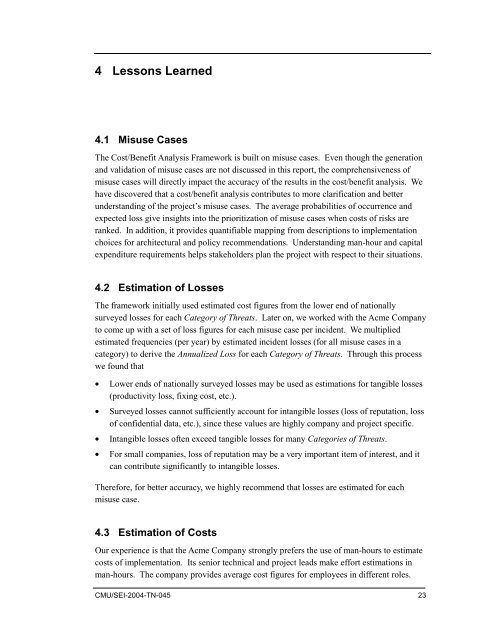SQUARE Project: Cost/Benefit Analysis Framework for Information ...
SQUARE Project: Cost/Benefit Analysis Framework for Information ...
SQUARE Project: Cost/Benefit Analysis Framework for Information ...
Create successful ePaper yourself
Turn your PDF publications into a flip-book with our unique Google optimized e-Paper software.
4 Lessons Learned<br />
4.1 Misuse Cases<br />
The <strong>Cost</strong>/<strong>Benefit</strong> <strong>Analysis</strong> <strong>Framework</strong> is built on misuse cases. Even though the generation<br />
and validation of misuse cases are not discussed in this report, the comprehensiveness of<br />
misuse cases will directly impact the accuracy of the results in the cost/benefit analysis. We<br />
have discovered that a cost/benefit analysis contributes to more clarification and better<br />
understanding of the project’s misuse cases. The average probabilities of occurrence and<br />
expected loss give insights into the prioritization of misuse cases when costs of risks are<br />
ranked. In addition, it provides quantifiable mapping from descriptions to implementation<br />
choices <strong>for</strong> architectural and policy recommendations. Understanding man-hour and capital<br />
expenditure requirements helps stakeholders plan the project with respect to their situations.<br />
4.2 Estimation of Losses<br />
The framework initially used estimated cost figures from the lower end of nationally<br />
surveyed losses <strong>for</strong> each Category of Threats. Later on, we worked with the Acme Company<br />
to come up with a set of loss figures <strong>for</strong> each misuse case per incident. We multiplied<br />
estimated frequencies (per year) by estimated incident losses (<strong>for</strong> all misuse cases in a<br />
category) to derive the Annualized Loss <strong>for</strong> each Category of Threats. Through this process<br />
we found that<br />
• Lower ends of nationally surveyed losses may be used as estimations <strong>for</strong> tangible losses<br />
(productivity loss, fixing cost, etc.).<br />
• Surveyed losses cannot sufficiently account <strong>for</strong> intangible losses (loss of reputation, loss<br />
of confidential data, etc.), since these values are highly company and project specific.<br />
• Intangible losses often exceed tangible losses <strong>for</strong> many Categories of Threats.<br />
• For small companies, loss of reputation may be a very important item of interest, and it<br />
can contribute significantly to intangible losses.<br />
There<strong>for</strong>e, <strong>for</strong> better accuracy, we highly recommend that losses are estimated <strong>for</strong> each<br />
misuse case.<br />
4.3 Estimation of <strong>Cost</strong>s<br />
Our experience is that the Acme Company strongly prefers the use of man-hours to estimate<br />
costs of implementation. Its senior technical and project leads make ef<strong>for</strong>t estimations in<br />
man-hours. The company provides average cost figures <strong>for</strong> employees in different roles.<br />
CMU/SEI-2004-TN-045 23
















